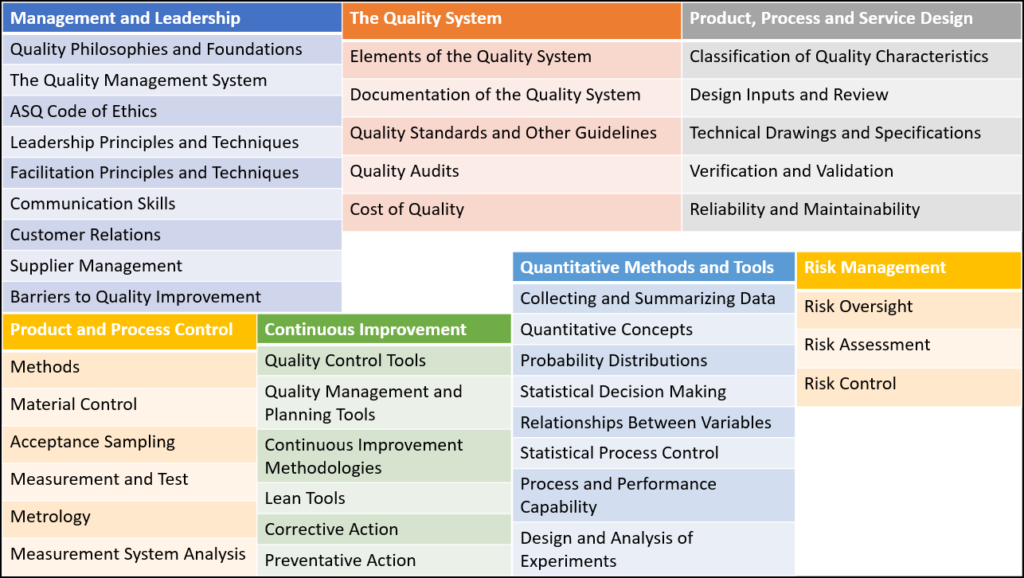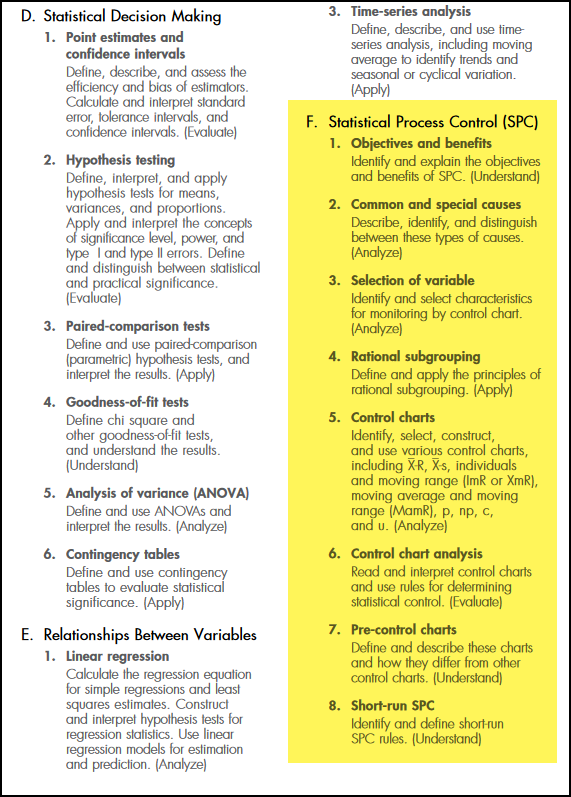And I felt COMPLETELY OVERWHELMED.
There’s A LOT there.
7 different pillars, which 42 individual topics, and a bunch of sub-topics.

Buzz-words and statistics. . . . yuck!
But after teaching this for 10 years, and passing the exam 3 times, I’ve stumbled onto a secret.
 The pareto principle applies to the CQE Exam.
The pareto principle applies to the CQE Exam.
You know the pareto principle, or the 80/20 rule – It’s one of the 7 QC Tools.
80% of the exam questions come from 20% of the topics.
And I want to share these with you to help you focus your study time on the most important topics, so that on exam day, you’re as prepared as possible!
So, what are those key topics?
Well, here they are in order of how they show up in the CQE body of knowledge:
- Reliability and Maintainability
- Acceptance Sampling
- Measurement System Analysis
- The 7 Quality Control Tools
- The 7 Management and Planning Tools
- Lean Tools
- Probability Distributions
- Statistical Decision Making
- Statistical Process Control

It’s 9 topics, but within Statistical decision making there are 2 really important topics, Confidence Intervals and Hypothesis Testing.
So, I rounded up to an even 10 MUST KNOW topics!
 The Normal Distribution is the Best Example
The Normal Distribution is the Best Example
The normal distribution is easily the most important topic on the CQE Exam.
Because it is the foundation of MANY of the topics within Statistics.
This includes ideas like process capability, confidence intervals, hypothesis testing, statistical process control, linear regression, and ANOVA Analysis.
So much of the Statistics portion of the exam is based on the normal distribution, and if you don’t understand this concept, the probability of you passing the exam is low.
 Statistical Process Control is another great Example!
Statistical Process Control is another great Example!
The 80/20 rule doesn’t stop with us just identifying critical topics.
We can take this approach even further and find critical concepts WITHIN critical topics.
The critical few as Deming put it.
Statistical Process Control is a great example of this concept.
The body of knowledge for SPC has 8 different sections:
- The Objectives and Benefits of SPC
- Common and Special Cause Variation
- Selection of Variables
- Rational Subgrouping
- Control Charts
- Control Chart Analysis
- Pre-Control Charts
- Short-Run SPC
After all these years, I’ve realized that one of these concepts is the most important.
Attribute and Variable Control charts.
On the CQE Exam you’re going to be asked (multiple times) to calculate control limits for these various control charts.

X-Bar and R charts, I-MR charts and attribute charts like the P chart or the U chart.
A Free Course to Help You Prepare Effectively for the CQE Exam!!!
Knowing the top 10 topics on the CQE exam will help you optimize your study time, and help you be as prepared on exam day as possible.
But I want to go even one step further!
I created aFREE ONLINE COURSE that that covers all of these key concepts within these 9 topics.
These lectures are an excerpt from my online course, The CQE Master Class.
If you’re preparing for the CQE exam, this is a must have resource.
It’s completing free to sign up.
Head over to www.CQEAcademy.com/Freecourse
This is a 2-week, 10-day course is structured a lot like my full course (The CQE Master Class).
Everyday you’ll get an email with a video lecture, a practice quiz and downloadable training material!
The practice quiz will also include questions from other topics so you engage in mixed practice and spaced repetition.
Like I said, if you’re preparing for the exam, or just considering it, this is a must have resource.